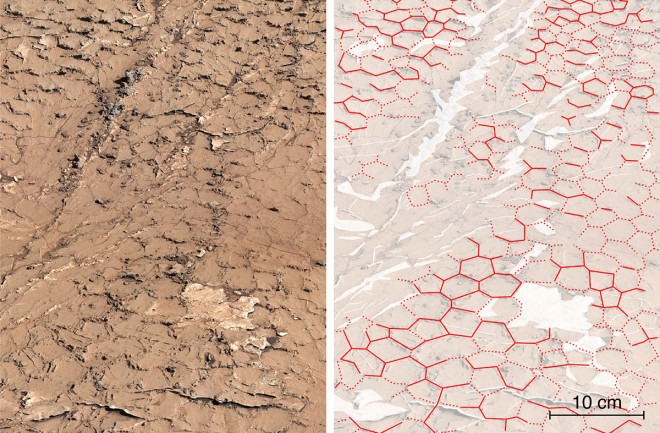A new discovery concerning Gale Crater mud on Mars increases the likelihood that the planet has developed some form of life in the past. This time, it’s not the composition of the mud, but its dried-out, cracked pattern of neat hexagons that matters.
When mud dries, it typically forms a more squared-off pattern. But when mud dries, re-moistens, and dries again repeatedly, the pattern can shift to board-game-like hexagons.
“This is the first tangible evidence we’ve seen that the ancient climate of Mars had such regular, Earth-like wet-dry cycles,” said William Rapin, a research scientist at France’s Institut de Recherche en Astrophysique et Planétologie, in a statement.
Muddy Hexagons
Since NASA’s Curiosity rover touched down on Mars in 2012, it has explored the planet’s Gale Crater, a 95-mile-wide basin believed to have once contained a large lake. The setting has helped scientists learn a great deal from Mars’ dried-up, ancient mud.
In 2016, the rover sampled clay from the crater that turned out to be glauconitic clay, which forms only under low-acidity conditions that are hospitable to life.
And in 2021, the rover came across mudstone partway up the mountain in the center of the Gale Crater, in a transition area positioned between two different types of sediment. Below lay a clay-rich layer, the stuff that forms through contact with water, and above lay a salted layer that forms from drier conditions. Caught between, the hexagonal mud had alternated between wet and dry, like a good risotto as it cooks.
Researchers found the muddy hexagons in 3.6 billion-year-old mudstone, where sulfate salts had cemented the cracks in place, preserving them for those billions of years. The pattern extended down into the stone for at least 4 inches, indicating that repeated wet and dry cycles had layered sediments onto the surface.
Scientists believe such wet-dry cycles accelerate evolution by helping along the complex organic molecules needed for life. A too-wet planet is too slow to produce them, and a too-dry planet starves certain reactions of water.
Why Does Dryness Support Evolution?
Life has many building blocks, and many have been found on Mars, including carbon, certain catalytic metals, and the right sources of energy. In a place like Gale Crater, a dry spell would pull these ingredients together into a highly reactive brine.
“As these elements and organic molecules are forced closer and closer together with increasing salinity,” said Juergen Schieber, professor of geology at Indiana University Bloomington, in a statement. “They may start polymerizing and make longer chains, creating the conditions for spontaneous chemistry that may start the complex chemical evolution that could lead to living organisms.”
“Wet-dry cycles are helpful,” Rapin said, and “maybe even required for the molecular evolution that could lead to life.”
Read More: Chasing Life on Mars

